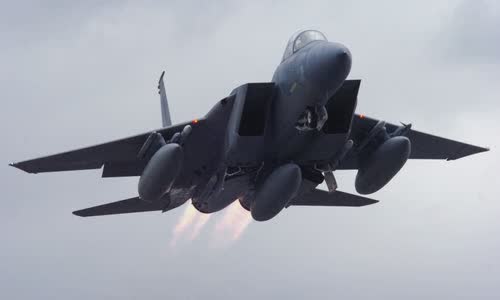The F-15C had to launch all the missiles it brought into the sea when the problem was more responsive in 2019, according to the US Air Force report.
The F-15C fighter of the US National Guard made an emergency landing at Portland International Airport due to a problem with the landing gear system shortly after takeoff on February 20, 2019.

The 142nd Airborne F-15C fighter took off with a full range of active weapons Photo: USAF
The faulty F-15C was codenamed 78-0473 and called "Rock 42", the callout commonly used for fighters on active duty and fully loaded with missiles.
This is a modal window.
Beginning of dialog window.
End of dialog window.
Despite planning a training mission, Rock 42 is still equipped with a base of combat weapons including four AIM-120C medium-range air-to-air missiles, two AIM-9X short-range air-to-air missiles, 940 size 20 rounds.
"Preparations under the ground are normal," the US Air Force incident report reads.
Not long after that, the pilot on Rock 42 discovered that the error system could not be obtained on the left side and had to maintain the speed below 400 km / h to not cause damage.
Pilot Rock 42 performed a troubleshooting procedure by dropping and retrieving the entire landing gear, but his crew member reported that the left wing was still in the drop position, not in the fuselage.
Rock 42 then declared a state of emergency and prepared for an emergency landing at Portland International Airport.
The F-15C fired all 48 MJU-10 / B bait bullets without problems.
The second collection and release did not yield results, but Rock 42's teammates discovered that hydraulic oil was gushing out and covered the left wing of the plane.
At this point, the fuel on Rock 42 is also running out.
Rock 42's teammates tried dropping and refueling from Expo 91 at a speed of 425 km / h to ensure this move could be done safely.
"The technicians announced that the aircraft will need a 75 km long line of fire, 22 km wide at minimum altitude to launch," the US Air Force report said.
The fog off the Oregon coast prevented Rock 42's teammates from checking their airspace and surface to make sure there were no civilian vehicles on the line of fire.
"During the first dive, the pilot dropped the AIM-120C missiles on mounts 3 and 7 on either side of the fuselage. The captain witnessed two bullets separate from the plane and fall into the sea, then hit
Rock 42 then launched two AIM-120C shells into the sea for the second dive and two AIM-9Xs in the third.
The report does not state the reason why Rock 42 freed the first two AIM-120C bullets, while the other four had to be fired as combat.
The F-15C crashed and then returned to Portland International Airport, landed safely and quickly stopped on the tarmac thanks to the BAK-12 flywheel clusters and brakes installed at the airport.
However, during the braking process, the pilot causes the nose of the aircraft to suddenly rise about 30 cm above the runway, causing the brake hook to jerk and pull the steel brake cable.
Rescuers quickly approached the plane in distress and took it to the brothel to assess the damage.
The cause of the problem and the remedy have been highlighted in the report.
The report revealed the level of damage on the F-15C was 418,280 USD, of which all damaged parts could be repaired.
The Pentagon's budget report says each AIM-120C costs about $ 1 million.
The F-15C is part of the 142nd Fighter Squadron, one of the units that protects the American sky against threats.



 Angela Akenson
Angela Akenson







